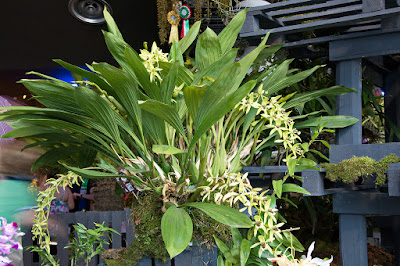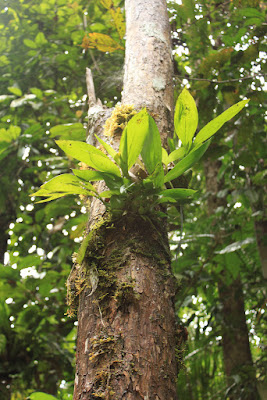Coelogyne pandurate were found in Malaya, Sumatra, Borneo and the Philippines - on the islands of Mindanao, Luzon and Samar. They usually grow on old trees near rivers, near the coast or on hot, humid and swampy lowlands...
Coelogyne pandurata also called as The Lute-Shaped Coelogyne, Coelogyne peltastes var. unguiculata, Pleione pandurata, is a species of the genus Coelogyne. This species was described by John Lindley in 1853.
IDENTIFY COELOGYNE PANDURATA
Coelogyne pandurata were found in Malaya, Sumatra, Borneo and the Philippines - on the islands of Mindanao, Luzon and Samar. They usually grow on old trees near rivers, near the coast or on hot, humid and swampy lowlands.
It is a large sized, hot growing epiphyte found on large trees near rivers or terrestrial with well-spaced, strongly compressed, oblong or suborbicular, sulcate pseudobulb carrying 2, apical, plicate, elliptic-lanceolate, leaves with a stout petiole.
The Lute-Shaped Coelogyne blooms in late spring-summer out of the center of newly emerging growths with up to 15 flowers on a terminal, arched to pendant, 15 to 30 cm long, racemose inflorescence. The simultaneously opening flowers are 7.5-12.4 cm in diameter, highly fragrant of honey but are short lived. The internal and external petals are uniform, pale-green to yellow-green. The upper outer petal is inclined forward over the prone, and the inner and outer lateral flakes are wide open. The blue-green lip is broad and impressive with a wavy edge. The ruffle has dark green accents and irregular, dark brown and black spots in its throat.
COELOGYNE PANDURATA CARE AND CULTURE
Cultural information should only be used as a guide, and should be to be adapted to suit you. Your physical location; where you grow your plants, how much time you have to devote to their care, and many other factors, will need to be taken into account. Only then can you decide on the cultural methods that best suit you and your plants.
Light:
Coelogyne pandurata needs a light level of 35000-40000 lux. These plants grow very well in low light, but usually they will not bloom unless sunlight is stronger. If the plants grow in high level of light, it is necessary to ensure good air movement.
Temperature:
It is a thermophilic plant. In summer, the average day temperature is 31-32 ° C, the night 23 ° C, which gives a daily difference of 8-9 ° C. In winter, average temperatures are 30-31 ° C during the daytime and 23 ° C at night, with a difference in daily variations of 7 ° C.
Humidity:
The Lute-Shaped Coelogyne needs the humidity of above 50-60% with strong air movement throughout the year.
Substrate, growing media and repotting:
Baskets, clay or plastic pots with permeable and airy, easily drying substrate are recommended. When clay pots are used, a mixture of 80% of medium-sized pieces of pine bark with 10% cut sphagnum moss and 10% of medium-sized pieces of tree ferns gives good results. It is best to overdo it when most newly mature pseudobulbs (those that have created new flowers) begin to grow new roots. This can be a bit confusing, as the plants bloom with new increments before the leaves and pseudobulbs develop. At this time, the growth of new roots can be observed, but they appear on rhizomes combining new and old growths.
Repotting should be postponed until the flowering has finished, the new growths will mature, and in the new pseudobulbs the growth of new roots will start.
Watering:
Precipitation is very abundant during the year. Let the Coelogyne pandurata plants dry before the next watering, but they should never completely dry out.
Fertilizer:
During the period of strong growth, the plants should be fertilized every week with 1/4-1/2 of the recommended dose of fertilizer for orchids. To avoid the accumulation of mineral deposits during periods of strong fertilization, it is recommended to rinse the containers approximately every month. Rinsing is particularly important where the water is highly mineralized. First, normally, the plant should be watered to dissolve the accumulated salts, and after about an hour, rinse the substrate with water equal to twice the volume of the container.
Rest period:
During winter, no watering should be made during this period, especially if Coelogyne pandurata plants are grown at higher latitudes. The substrate should almost completely dry before the next watering, which means reducing the frequency of watering. The light should be kept as high as possible, so as not to burn the leaves.















COMMENTS